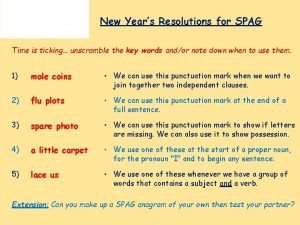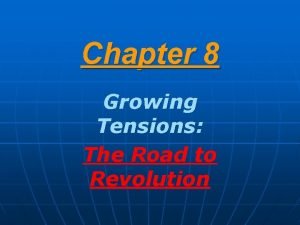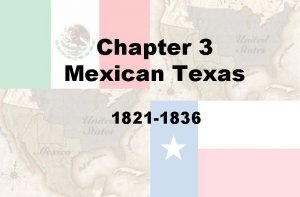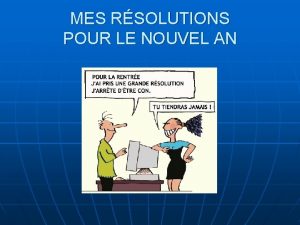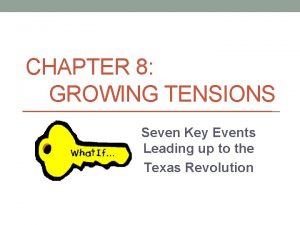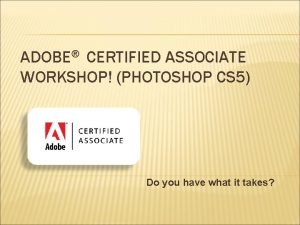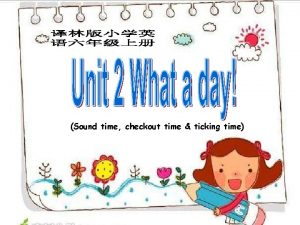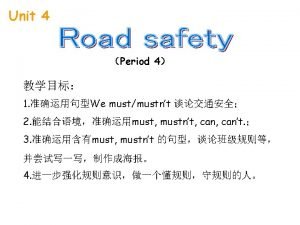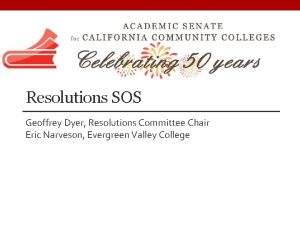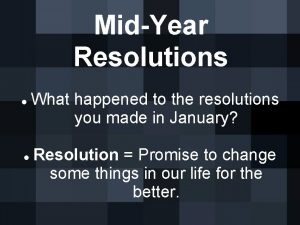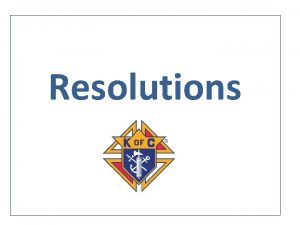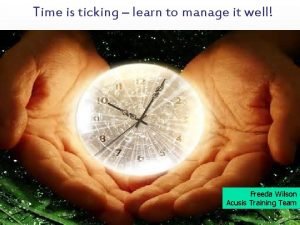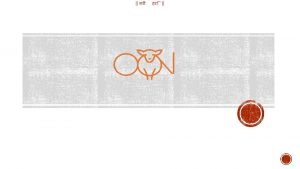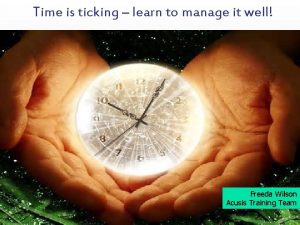New Years Resolutions for SPAG Time is ticking




















- Slides: 20

New Year’s Resolutions for SPAG Time is ticking… unscramble the key words and/or note down when to use them. 1) semi-colon mole coins • We can use this punctuation mark when we want to join together two independent clauses. 2) flu plots full stopirony • We can use this punctuation mark at the end of a full sentence. 3) apostrophe spare photo • We can use this punctuation mark to show if letters are missing. We can also use it to show possession. 4) a little letter carpet capital • We use one of these at the start of a proper noun, for the pronoun “I” and to begin any sentence. 5) lace us clause • We use one of these whenever we have a group of words that contains a subject and a verb. Extension: Can you make up a SPAG anagram of your own then test your partner?

Time is ticking… unscramble the key words and/or note down when to use them. 1) semi-colon Semi colon • We can use this punctuation mark when we want to join together two independent clauses. 2) Full stopirony stops full • We can use this punctuation mark at the end of a full sentence. 3) Apostrophe apostrophe • We can use this punctuation mark to show if letters are missing. We can also use it to show possession. 4) Capital letters capital • We use one of these at the start of a proper noun, for the pronoun “I” and to begin any sentence. 5) Clause clause • We use one of these whenever we have a group of words that contains a subject and a verb. Extension: Can you make up a SPAG anagram of your own then test your partner?

Learning objectives: • To understand how to avoid basic SPAG errors; • To be able to set effective literacy targets.

Activity 1: Capital letters 1) 2) 3) 4) 5) the shortest month of the year is february. Sam and jane went to a restaurant in leeds. how many easter eggs did you receive? We went on holiday to mallorca with george. My friends and i love eating chinese food. Extension: Using your green pen, annotate the examples to explain why you have used each capital letter.

Activity 1: Capital letters 1) 2) 3) 4) 5) Use your green pen to tick or correct your answers… The shortest month of the year is February. Sam and Jane went to a restaurant in Leeds. How many Easter eggs did you receive? We went on holiday to Mallorca with George. My friends and I love eating Chinese food. Now give yourself a mark out of ten…

Activity 2: Tricky spellings 1) definitely 2) lose 3) weird How can I improve my spelling? 1. The old-fashioned way: Look – cover – say – write – check 2. Use a dictionary or Microsoft Word to check your work. 4) separate 5) surprise 6) happened 3. Find a visual way to remember the letters: 7) appearance 8) they’re 9) their 10) there 4. Use a silly saying: “There’s definitely a nit in my hair. ” 5. Download a free app called My Spelling Test.

Activity 3: Ending sentences When is the right time to use each of these? ! . … ? = full stop = exclamation mark = question mark = ellipsis

Activity 3: Ending sentences 1) 2) 3) 4) 5) 6) 7) 8) Stop it The door opened What a surprise Do you know what time it is The wind whistled outside They waited and waited How hungry are you It is my favourite place . ! = exclamation mark ? … = full stop = question mark = ellipsis You have to use each punctuation mark twice. How can you end these sentences? Extension: Using your green pen, annotate the examples to explain why you have used each punctuation mark.

Activity 3: Ending sentences 1) 2) 3) 4) 5) 6) 7) 8) Stop it! The door opened… What a surprise! Do you know what time it is? The wind whistled outside. They waited and waited… How hungry are you? It is my favourite place. Now give yourself a mark out of eight…

Activity 4: Commas What are the main reasons to use commas? 1) To separate items in a list: • You will need butter, eggs, milk and flour. • They played FIFA, Call of Duty and Assassin’s Creed. 2) To separate two adjectives before a noun: • It was a cold, windy night. • He drove an old, rusty car.

Activity 4: Commas 3) To separate the main clause from another clause in a compound or complex sentence: • I support Forest, but my friend supports County. • My dad, who hates East. Enders, switched off the TV. • As it was sunny, we spent the whole day outside. 4) To separate an adverbial from the beginning of a sentence: • Unfortunately, it was time to get out of bed. • In the blink of an eye, everything had changed.

Activity 4: Commas Do these sentences use commas correctly or incorrectly? Why? It was a warm, sunny day in Nottingham. I heard a loud bang, which made me jump. Finally, wehad reached beach. Finally we reached thethe beach. He loved but he he waswas scared to go loved to toswim, but scared toingo in likes football, basketballand tennis. 1. She likes, football basketball tennis. 2. 3. 4. 5. the sea.

Activity 5: Apostrophes 1) Im going to Catherines party tomorrow. 2) Kanes first goal should have been offside, but the referees decision was final. 3) We dont know if theyre going to be there. 4) The three girls bags were all exactly the same as Sarahs. 5) Ive heard that a lot of schools canteens serve fish and chips on Fridays. Extension: Using your green pen, annotate the examples to explain why you have used each apostrophe.

Activity 5: Apostrophes 1) I’m going to Catherine’s party tomorrow. 2) Kane’s first goal should have been offside, but the referee’s decision was final. 3) We don’t know if they’re going to be there. 4) The three girls’ bags were all exactly the same as Sarah’s. 5) I’ve heard that a lot of schools’ canteens serve fish and chips on Fridays. Now give yourself a mark out of ten.

Activity 6: Semi-colons When is the right time to use a semi-colon? • We can only use a semi-colon if we have two independent clauses. e. g. He likes pears and she likes apples. • Remember, a clause is independent if it could work as a full sentence on its own. e. g. He likes pears. She likes apples. • The semi-colon slots in between the two clauses so that you avoid using ‘and’ or starting a new sentence. e. g. He likes pears; she likes apples.

Activity 6: Semi-colons • Semi-colons are particularly useful if one of the independent clauses already includes the word ‘and’. • For example, which of these sentences is easiest to understand? He likes oranges and pears and she likes apples. He likes oranges and pears; she likes apples. • Semi-colons add variety to our writing; they also help us to show off our control of punctuation.

Activity 6: Semi-colons 1) My favourite countries are Greece and Spain; I really enjoy Mediterranean food. 2) Zara didn’t want a big party she didn’t like loud noises. 3) Adam really hoped it would snow he hadn’t used his sledge in years, but he knew exactly where it was. 4) Katie always remembered her planner her brother wasn’t so well-organised, however. 5) The worst part of the holiday was the journey there and back I always suffer from travel sickness. Extension: Using pictures instead of words, can you explain the rule for using semi-colons?

Activity 6: Semi-colons If it helps, highlight the different clauses using a different colour. 1) My favourite countries are Greece and Spain; I really enjoy Mediterranean food. 2) Zara didn’t want a big party; she didn’t like loud noises. 3) Adam really hoped it would snow; he hadn’t used his sledge in years, but he knew exactly where it was. 4) Katie always remembered her planner; her brother wasn’t so well-organised, however. 5) The worst part of the holiday was the journey there and back; I always suffer from travel sickness. Now give yourself a mark out of five.

Learning objectives: • To understand how to avoid basic SPAG errors; • To be able to set effective literacy targets.

Set a target: • Look back through today’s activities. • What do you need to improve the most? • How will you do it? • My New Year’s resolution for SPAG is… • I will achieve this by…
 Spag nebulizer
Spag nebulizer Greater depth writing year 2
Greater depth writing year 2 Unscramble ticking
Unscramble ticking Turtle bayou resolutions
Turtle bayou resolutions What did mier y teran observe in texas
What did mier y teran observe in texas Mes resolutions pour le nouvel an
Mes resolutions pour le nouvel an Resolutions size
Resolutions size Turtle bayou resolutions drawing
Turtle bayou resolutions drawing Resolutions size
Resolutions size First call resolution presentation
First call resolution presentation Fredonian rebellion facts
Fredonian rebellion facts Njbta
Njbta Goat years to human years
Goat years to human years 300 solar years to lunar years
300 solar years to lunar years Four score and twenty
Four score and twenty Start time, end time and elapsed time
Start time, end time and elapsed time New years sermon outline
New years sermon outline Iso 22301 utbildning
Iso 22301 utbildning Novell typiska drag
Novell typiska drag Nationell inriktning för artificiell intelligens
Nationell inriktning för artificiell intelligens Vad står k.r.å.k.a.n för
Vad står k.r.å.k.a.n för


